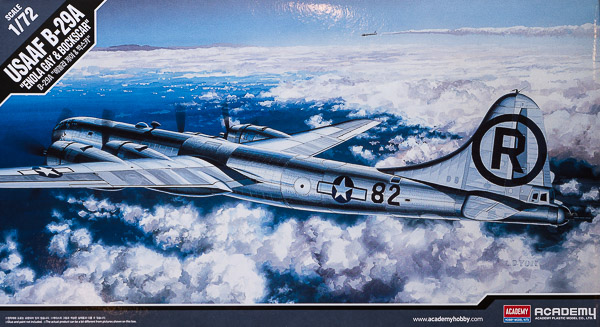
Academy 1/72 Boeing B-29A Superfortress "Enola Gay & Bockscar"
By Chris Banyai-Riepl
Overview
The Boeing B-29 Superfortress holds the distinction of being the only plane to drop nuclear weapons on wartime targets, a move that killed hundreds of thousands and destroyed two cities, brought about a quick end to the war in Japan, and started the Cold War and nuclear arms race. The actions of those two aircraft, the Enola Gay and Bockscar, overshadowed many of the other achievements of the B-29, such as becoming the first Air Force refueling tanker. The B-29 also launched the X-1 into the record books, flew into hurricanes for research, and became China's first AWACs aircraft. For an aircraft that was rushed into production during the war, the B-29 made quite an impact in 20th Century aviation.
The Kit
The Academy 1/72 B-29 Superfortress kit has been out for quite a few years now, and it remains the best choice for this famous plane in this scale. Featuring recessed panel lines, a decent interior, and of course an open bomb bay, this kit will give you a good looking B-29 model. Re-releases over the years have seen decal changes and version changes, including the KB-29 tanker. This release goes back to those original famous pair of B-29s, the Enola Gay and Bockscar, both of which had modifications to their airframe for those special missions.
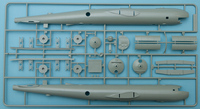
|
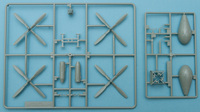
|
Starting with the interior, this is actually pretty good considering the age of the kit. You get a full cockpit set, with seats, instrument panels, control columns, tables, and more. There is also a rear section that has further bits and pieces, along with the connecting tube that links up these two separate pressurized sections of the fuselage. The rear gunner position is also detailed. All of this detail, though, is not going to be very visible as the available windows are small and the light will be dim. In fact, you could leave out the entire rear compartment, as none of it will be seen. This is a wise move, too, as this plane is a notorious tail sitter so anything you can do to limit the weight behind the main gear, the better.
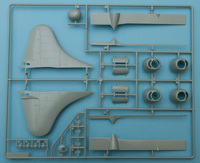
|
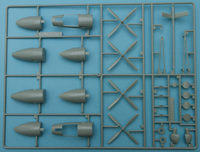
|
For the bomb bay, there are separate side structures and detailed mounts for the two styles of nuclear bombs, both of which are included in the kit. There is also a three-piece spar that completes the bomb bay interior. Once the crew sections are included, with their pressure bulkheads and that distinct connecting tunnel that runs through the top of the bomb bay, your primary fuselage assembly will be complete. To convert that assembly into one of the Silverplate B-29s used on the atomic runs, you need to remove the turrets. The kit comes with blanking plates, but you will still need to shave off the surrounding lip on the fuselage. While you're doing this, you will also want to fill in the aerial refueling receptacle panel lines on the forward upper fuselage, a problem with using a single common mold for multiple variants.

|
For the control surfaces, the vertical fin is separate, split into right and left halves, and features a very large and positive mounting tab. The horizontal stabs are also split into upper and lower halves. If you are feeling particularly skilled, a bit of work with a grinder on the insides of these (and the rear fuselage, for that matter) could help alleviate that massive nose weight issue. The wings are long and thin, which means they're prone to warping, so check that before assembling. The flaps are separate, as are the engine nacelles.
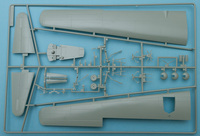
|
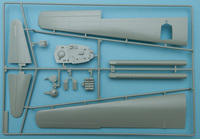
|
Looking at the engine nacelles, for the most part these are decent. You get a bulkhead with an engine face molded in place for the engine detail, and given the closeness of the cowlings, that's more than enough. One thing that is missing are the cooling gills for the turbosuperchargers. You can add these from a photoetch detail set, or scratch them from some thin plastic card. For the inboard nacelles, these incorporate the main wheel wells, and these are rather bare. Final assembly adds the landing gear, the bomb bay doors, a radar bulge on the fuselage bottom, and various antennae along the fuselage top.
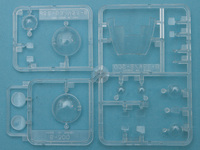
|
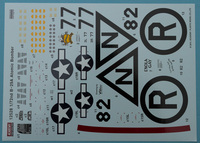
|
For painting, break out your gallons of silver because your choice is silver, or silver. The B-29 was a large plane, which meant a lot of paint to cover it. A lot of paint meant a big reduction in performance from the added weight, so that was left off of these planes. Photos show them to be highly polished, too, so you'll want to pick a silver that has a good amount of shine to it. For decals, both aircraft have large tail markings: Circle R for Enola Gay and Triangle N for Bockscar. Aside from that and the rear fuselage numbers, about the only other markings on these planes are the nose art (name in Enola Gay's case). The decals are well printed and include a bit of stenciling as well.
Conclusion
While this is the best of two choices in 1/72 for the B-29, it remains a solid option for those wanting to build a Superfortress in this scale. My thanks to MRC for the review copy.
